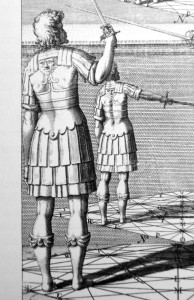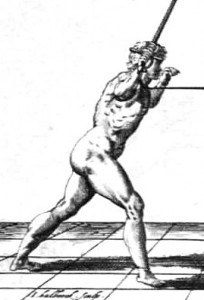In the 16th century, cuts begin to be sorted according to the portion of the arm that moves while delivering the cut. I don’t know exactly when that notion popped up; the earliest advice of the sort that I know of is in Di Grassi (the original dates from 1572):
The Arm likewise is not in every part of equal force and swiftness, but different in every bowing thereof, that is to say in the wrist, in the elbow and in the shoulder: for the blows of the wrist as they are more swift, so they are less strong: and the other two, as they are more strong, so they are more slow, because they perform a greater compass. Therefore by my counsel, he that would deliver and edge blow shall fetch no compass with his shoulder, because while he beareth his sword far off, he giveth time to the wary enemy to enter first; but he shall only use the compass of the elbow and the wrist; which, as they be more swift, so are they strong enough, if they be orderly handled.
Giacomo di Grassi, His True Art of Defence, 1594 edition in English
Another example in Fabris:
The same cuts can be delivered in four different ways. Some execute them from the shoulder, others from the elbow, others from the wrist; others yet from the shoulder but with the arm and the wrist extended and stiff, with the point pretty much always in-line with the opponent.
Salvator Fabris, Lo Schermo, overo Scienza d’Arme, trans. Tom Leoni
The existence of the fourth way tends to indicate that a cut from the shoulder (first way) also involves bending the wrist and elbow, so that the whole arm from the shoulder down participates. Same goes for cuts from the elbow, of course. I’m not going to quote in full since it’s a whole chapter, but Fabris goes on to point out that cuts from the shoulder, while powerful, expose the fencer too much. Cuts from the elbow are seen as a little better, cuts from the wrist even better: as the arm remains in line, there is no large opening for the opponent to take advantage of.
Capoferro shows a preference for cuts from the elbow:
[…] please be advised that mandritti and riversi are delivered from the elbow and (tempo and measure allowing) with the help of the upper arm.
Ridolfo Capoferro, Gran Simulacro dell’Arte e dell’Uso della Scherma, trans. Tom Leoni
What ‘with the help of the upper arm’ exactly covers is a bit unclear. It may refer to a smaller rotation around the shoulder joint. The link to time and measure is echoed in Thibault:
[…]it is possible to move the whole arm to deliver a cut to the enemy from the first Instance. […] One should move only from the elbow to do the same from the second. […] Upon the third Instance […] it can only be done from the wrist. […] At the second and third Instances, the body is so close, that as much as it uncovers itself, and as much time that gives to the opponent to do something, is as many unavoidable dangers that are chanced.
[…]
What we say about cuts must also be held true for thrusts. Because it is the observation that gives us the ability to moderate all the motions according to their time.Girard Thibault, Académie de l’Espée, trans. mine
I’ve already written about Thibault’s Instances before, basically the first Instance is the furthest from the opponent (think one full step), and the third is the closest (where you stand when you can wound without moving the feet). The furthest you are form the opponent the bigger the opening you can afford in your defence.
Illustrations

A cut done ‘with the help of the elbow’ in Thibault. Foreground shows the cut chambered, background shows it diverted by the opponent.
Given that there are few depictions of people in the act of cutting (see my previous article here), it is not surprising that there are even fewer unambiguous representations of people doing one of the three variants. The image on the right, from Fabris, is meant to show a cut from the elbow according to the text. It is however not very obvious, because the upper arm has clearly moved out of line as well. Is this indicative of the involvement of the upper arm recommended by Capoferro? Hard to know.
There is also the image on the left from Thibault, table XVII, where a cut ‘executed with the help of the elbow’ is presented. Here too the upper arm has moved a bit but not so much, so this is as far as I know the best illustration of the position of the arm during a cut from the elbow. It also shows in the background how the arm can swing past the target rotating from the shoulder, even for a cut from the elbow. Presumably this may be true for cuts from the wrist as well.
Interpretative remarks
I think this classification came to light when people started to fight predominantly with the sword and arm pointed to the opponent. From any posture with the arm retracted, you are almost surely going to cut from the shoulder according to that classification, because your starting posture is exactly as opened as it is when you chamber a cut from the shoulder. The only difference is that you will not offer an exploitable opportunity as you lift your arm. The quote from Thibault would make me very defiant of an interpretation that lets the fighter get close enough to wound firm-footed while in an open posture.
The underlying trade-off is power vs. speed vs. openings. This should be kept in mind when cutting according to earlier styles; if you cut from the shoulder, you have to do so in such a way that you can gather more energy, otherwise you would waste the large opening without any compensation. The cut from the elbow, having more potential for power than the cut from the wrist but tighter openings than the cut from the shoulder seems a happy medium, which might have been why Capoferro singles it out.
Although the advice here is predominantly geared towards single-handed weapons, some of it still applies to two-handed weapons, mainly the trade-off between how large the swing is and how powerful it can be.




Hi Vincent,
This is a very interesting investigation, and intriguing to see the ‘power-speed’ trade-off mentioned.
I wrote about this in about 2006, but focussing more on Silver’s timings, as well as the defining aspects of the Liechtenauerian Zornhau. I’ve used Thibault before (based upon J M Greer) & DiGrassi, but the other references are very useful!
My theory relating to this based upon that of ‘Kinaesthesis’. If you’d kindly share your email address, I’d happily share this work with you. I’d be interested in have further cross-comparisons with your work if interested?
Keep up the good work!
All the best,
Hi!
Thanks for your appreciation!
I’m intentionally staying away from “Liechtenauer” sources because I’m not fond of the primary weapon and I find them much less clear than later texts. Likewise, I’m staying away from Silver (for now 🙂 ) because of the difficulty of interpreting that text. As for the rest, you can find my email at the bottom of the page by clicking on my name (with some spam protection 🙂 )!
Regards,